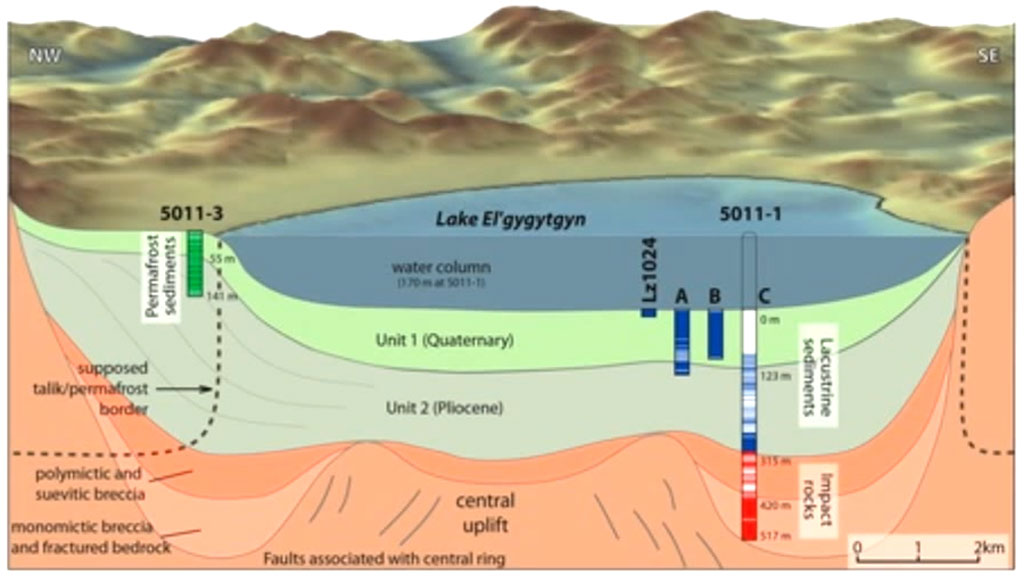Lake El’gygytgyn, Pleistocene super-Interglacials and Arctic warmth
John Mason / Skeptical Science: Here is a must-see 2012 […]
John Mason / Skeptical Science: Here is a must-see 2012 presentation by Julie Brigham-Grette of the University of Massachusetts Amherst, covering the research her team has been doing into Lake El’gygytgyn (pronouned El-Guh-Git-Kin), a water-filled meteor crater in Arctic Russia that came into being after the impact of a ~1km diameter space-rock, 3.6 million years ago.
This is incredibly important work because:
- The Lake El’gygytgyn region was not glaciated during any of the ice ages. As a consequence, the >300m accumulated sequence of lake sediments represents a continuous, undisturbed sedimentary record going all the way back from the present to the aftermath of the impact.
- The team succeeded in 2009 in extracting cores spanning this entire 3.6 million year period.
- The oldest continuous ice core records to date extend 123,000 years in Greenland and 800,000 years in Antarctica: the Lake El’gygytgyn cores go way back beyond those times and provide an unprecedented view of the past climate of the Arctic.
- Results show that during the Pleistocene (2.588 million – 11.7 thousand years ago), there were a number of super-interglacials – like the present period but much wetter and several degrees warmer in the Arctic, during which the Greenland and West Antarctic ice-sheets didn’t just melt a bit. They disappeared.
Skeptical Science recently covered the new 2013 paper by the same team, describing the Arctic climate in the Lake El’gygytgyn region during the Pliocene, when boreal forests extended well up into the Arctic and summer temperatures were 8oC warmer than they are at present:
The last time carbon dioxide concentrations were around 400ppm: a snapshot from Arctic Siberia
The data coming from Lake El’gygytgyn strongly suggest that the Arctic climate is highly sensitive to small changes in forcing, warming much faster than the rest of the world in the phenomenon known as Arctic Amplification. In recent years, Arctic Amplification has emerged as a strong modern-day climate signal. To cite but one example, the sea-ice response has been of far greater magnitude than model-based forecasts projected. Now, the past is giving a similar narrative, and understanding the climate of the past gives us our best chance of understanding the climate of the future.
Readers of Skeptical Science can expect to encounter more news from Lake El’gygytgyn in due course. In the meantime, why not watch the 24-minute video to see for yourself?
Mini-glossary:
* Marine Isotope Stages – oceanic sediment cores show that the ratios of the isotopes oxygen 16 and 18, as measured in the calcite shells of fossil foraminifera, vary through geological time with temperature. This is because oxygen 16 (in water vapour) is more easily lost to the atmosphere during ocean evaporation: in turn, during cold cycles, much more of it gets trapped in snow and ice. Hence, the O16/18 ratio varies at any given time depending on the volume of ice present on the planet. Each warm and cold cycle of thePleistocene has its own unique Marine Isotope Stage number assigned to it.
* Unconformity – in the video, reference is made to unconformities in Antarctic ocean sediment cores obtained during the ANDRILL programme. An uncomformity is a break in a sequence of sediments, typially caused by a period during which, for a whole lot of reasons, sedimentation is not occurring or erosion is taking place.
* Diatomaceous ooze – diatoms are microscopic marine plants with silica-based cell walls. They live in large numbers in the surface layers of the oceans, especially in circum-polar waters. Ooze is a fine-grained sediment that has accumulated by the settling of particles (such as dead diatoms) through the water column to the ocean floor far from land, indicative of the absence of glacial ice (land-based or floating shelves) and all the coarse sedimentary detritus it brings with it. In the Antarctic ocean-sediment cores, super-interglacials are marked by layers of diatomaceous ooze.
